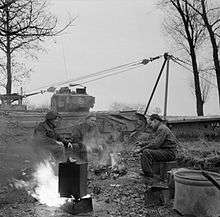Benghazi burner

The Benghazi burner or Benghazi cooker was the nickname of an improvised petrol stove or brazier, used by British Army troops and their Commonwealth and Imperial allies during the North African Campaign of the Second World War.
The Western Desert Campaign
The Benghazi burner itself consisted of a single empty steel fuel can - usually a 4 gallon (18 litre) type, known as a "flimsy"[1] – or a biscuit tin. The sides of the top half would have some holes pierced in it, and the bottom half would be filled with sand. Petrol (gasoline) would be stirred into the sand and it would then be ignited. A second can of the same size could be placed on top and used as a cooking vessel.[2] It was used because the standard pressure stove issued to armoured vehicle crews, known as the "Cooker, Portable No 2", was prone to blockages caused by sand.[3] The Benghazi burner had the advantages that it was silent, fast and that empty cans, sand and fuel were readily available in the desert.[4] The disadvantage was that it was unpredictable and the fuel would often burn out too early; it was tempting to add petrol to the hot sand with explosive results.[5] An additional use was as a beacon to illuminate desert airstrips.[1]
The importance of the Benghazi burner in the desert campaign was, at least in part, due to the fact that the water supplied to the front line was often transported in fuel cans; the resulting foul taste could be remedied by making tea with it. Although tea drinking was a long established custom in the British Army, (one account describes tea being liberally distributed on the morning of the Battle of Waterloo,)[6] the act of "brewing-up" (i.e., making tea) soon became "almost a ritual" in the desert campaign. Besides providing most of the men's hydration, the act of making and drinking tea also aided bonding and morale. One soldier recorded that morale was directly proportional to the "supply of brews" and that "tea had become as a drug to us". A battalion could use almost a hundred gallons (about 450 litres) of fuel per day in making tea. Recognising this, the British Government bought the entire world crop of tea in 1942.[7] The burners were also used to cook field rations; tinned corned beef - known as "bully beef" - could be fried and hardtack biscuits could be crushed and made into a kind of porridge known as "burgoo" or "biscuit la-la".[8]
Later developments

The burners were subsequently used during the Italian Campaign and in the North-West Europe Campaign.[5] Right at the end of hostilities, the latest Centurion tank was fitted with a boiling vessel or "BV" which supplied hot water heated by the tank's electrical system.[9] These are now fitted to almost every type of British military vehicle. Despite this, the Benghazi burner had a brief revival by British forces in the Gulf War of 1990–91, made from ammunition boxes.[10]
See also
- Kelly Kettle – a type of patent stove, known as a 'Thermette' in New Zealand,[11] that was also sometimes called a "Benghazi boiler" in World War II[1]
References
- 1 2 3 Hanson, Jonathan (17 August 2012). "Irreducible imperfection: The flimsy". Overland Expo. Retrieved 29 November 2013.
- ↑ Young, Denholm. "Desert brewup". British Forces in Palestine. Retrieved 29 November 2013.
- ↑ Robertshaw, Andrew (2012). Frontline Cookbook: Battlefield Recipes from the Second World War. The History Press. p. 39. ISBN 978-0752476650.
- ↑ Kennedy Smith, W.B. (1945). Long Range Desert Group. London: Collins. pp. 50–51.
- 1 2 Mitchell, Raymond (2001). Commando Despatch Rider: From D-Day to Deutschland 1944-45. Leo Cooper. p. 72-73. ISBN 0-85052-797-X.
- ↑ "A Soldier's Daily Ration". www.95th-rifles.co.uk. 2nd Battalion, 95th Rifles. Retrieved 6 October 2014.
- ↑ Fennell, Jonathan (2011). Combat and Morale in the North African Campaign: The Eighth Army and the Path to El Alamein. Cambridge University Press. p. 134. ISBN 978-0-521-19270-5.
- ↑ Fennell (2011), p. 137.
- ↑ Ware, Pat (2012). The Centurion Tank, Pen & Sword Books Ltd, ISBN 978-1-78159-011-9 (p. 11)
- ↑ Walker, Harlan. Oxford Symposium on Food and Cookery 1991: Public Eating: Proceedings, Prospect Books, ISBN 0-907325-47-5 (p. 13)
- ↑ Cryer, Max (2010). The Godzone Dictionary: Of Favourite New Zealand Words and Phrases. ReadHowYouWant.com. p. 203. Retrieved 3 January 2014.